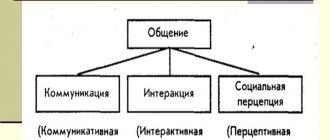tags:
Communication, Person, Communication, Attitude, Internal, Implementation, Partner, External B. Lomov (Boris Fedorovich Lomov - Soviet psychologist, specialist in the field of general, engineering and pedagogical psychology, as well as the psychology of cognitive processes) identifies three functions in communication:
- information and communication (consists in any exchange of information),
- regulatory-communicative (regulation of behavior and regulation of joint activities in the process of interaction
- affective-communicative (regulation of a person’s emotional sphere.
The information and communication function covers the processes of generating, transmitting and receiving information; its implementation has several levels: at the first level, differences in the initial awareness of people who come into psychological contact are equalized; the second level involves the transfer of information and decision-making (here communication realizes the goals of information, training, etc.); the third level is associated with a person’s desire to understand others (communication aimed at forming assessments of achieved results).
The second function - regulatory-communicative - is to regulate behavior. Thanks to communication, a person regulates not only his own behavior, but also the behavior of other people, and reacts to their actions, that is, a process of mutual adjustment of actions occurs.
Under such conditions, phenomena characteristic of joint activity appear, in particular, the compatibility of people, their teamwork, mutual stimulation and correction of behavior. This function is performed by such phenomena as imitation, suggestion, etc.
The third function - affective-communicative - characterizes the emotional sphere of a person, in which the individual’s attitude to the environment, including social, is revealed.
Listen to the other person until the end
Sometimes the tendency of people to interrupt each other can greatly spoil the subject of the conversation, its purpose and, in addition, leave the opponent with an unpleasant feeling of not being understood, or that he wasted time and resources.
This is caused by the habit of not listening to the end, interrupting - expressing your thoughts, showing an attitude, or completely devaluing the words of another, condemning or ridiculing him. Listening to your communication partner to the end means not “inserting” words and comments, even when it seems necessary, and especially not interrupting his speech with the words “but I had”... or “I think about this that...” and etc.
However, silent and distant listening can make it clear to the other that you are not at all interested in the subject of the conversation and are bored. Therefore, in order to maintain a conversation and not interrupt the interlocutor at the same time, you can use pauses in the conversation, during which you unobtrusively voice your opinion or give a comment. A conversation or conversation, to be effective, must proceed slowly and demonstrate respect for the opponent on all sides.
A useful habit of giving “reflection”
During communication, this technique can make the partner feel that he is very well understood, and accordingly, the conversation will be warm and friendly.
The reflection technique can also be used if there is a goal to improve relationships with another person - a boss, a close relative, a friend.
To reflect another means, after he finishes speaking, to repeat what was said in his own words, conveying the meaning and feelings of his partner as best as possible. For example, you can start with the words: “I understood you correctly that you...” - this is then followed by conveying the meaning of the words spoken to others. Or: “I understand how hurt you were, that you felt unwanted (unloved, deceived)” and so on.
Tests.
Correlate the proposed socio-psychological concepts and their definitions:
a) stereotype;
b) prejudice;
1) one-sided, distorted and, as a rule, prejudiced view, characteristic of representatives of professional, age, social, ethnic groups or classes;
2) personal antipathy or active hostility towards another social group; however, individuals may or may not participate in discriminatory activities based on their views.
Answer: a-2, b-1.
1) Stereotype - personal antipathy and active hostility towards another social group; however, individuals may or may not participate in discriminatory activities based on their views.
2) Prejudice is a one-sided, distorted and, as a rule, prejudiced view characteristic of representatives of professional, age, social, ethnic groups or classes.
Recommendations for the elderly
Older people often complain about a lack of communication. They strive to communicate and are ready to do this around the clock, but relatives perceive this as an intrusiveness. Experts give important advice that will help solve all problems. You just need to create a circle of like-minded people. This will happen as soon as a person finds something to his liking. It is necessary to join a community of interests, attend social events, and come up with interesting joint activities with your neighbors.
The idea that a person is lonely is more than erroneous. If there is such a feeling, it means that he simply does not want to communicate with others. You need to understand yourself, understand the reasons for your melancholy and actively engage in battle with a pessimistic attitude. You just have to look around and a huge number of people will immediately respond and want to be nearby.
Pursuer (Aggressor)
1) Before making claims, demanding something, criticizing, blaming and shaming other people, think carefully about whether you really need a result, or whether you just want to vent your anger.
2) Accept the idea that you are imperfect and can make mistakes.
3) Stop blaming other people for your problems.
4) Stop believing that others have to conform to your idea of what is right.
5) Find alternative ways to assert yourself.
6) If you want to get something from another person, try to push him in the right direction without physical or emotional violence.
Practical Methods for Developing Confidence
How can you become a more confident person? The main methods recommended by many psychologists are as follows:
Thought control. A person has about 65,000 thoughts per day. But 80-90 percent of them are negative - these are either worries, or worries, or warnings. Psychologists emphasize that these fears make a person more cautious and therefore cannot be unequivocally assessed in a negative way. But modern human life, for the most part, is not fraught with danger. Once you realize that these are just anxious thoughts, you can become much more confident. Have a goal. A confident person always knows what he wants from life. Knowing your purpose is the key to success. Start your morning with gratitude. This will allow you to tune in to a positive mood. If you start the day with gratitude, you can maintain a good mood until the evening. Leave your comfort zone. Communication can really make a person afraid. Most often, this reaction is due to past experiences. But in order to become more confident, you need to form a new attitude in yourself: to realize that communication could be unpleasant and dangerous in the past, and in the current situation there is absolutely nothing to be afraid of. This can only be done by accepting the challenge and entering into dialogue even when you don’t particularly want to do so. Workout. Language of communication is an art that includes not only verbal communication
It is also important in constructing a dialogue how a person behaves, what kind of posture he has, how he presents himself. Physical exercise and sports make you feel much more alert, which can’t help but affect your confidence.
Choose the right environment. If you are constantly around those people who devalue you, most likely this will affect your self-esteem in the most negative way. It is believed that each person is the arithmetic mean of the 5 people around her. Therefore, you need to be careful about your surroundings. Feeling of openness. Openness testifies to honesty, and honest people always create an aura of correctness and nobility around themselves and inspire trust. Openness is also acceptable when the interlocutors are close enough that the conversation should be simplified so that the participants in the conversation open up to each other and feel even more comfortable. However, this advice should only be used if people are willing and trustworthy to share personal information. There is no need to share your secrets with strangers. Otherwise, it will have the opposite effect and alienate others. And even if the chances of a good acquaintance were great, then if you are too frank in the initial stages of communication, you can ruin a potential friendship.
Rescuer
1) Do not impose services and do not give advice that you are not asked for.
2) Stop assuming that you know better how others should live.
3) Don't promise what you can't deliver.
4) Don't expect gratitude - everything you do, you do because you want it.
5) If you still count on reciprocal services, negotiate your conditions in advance.
6) Find alternative ways to assert yourself.
7) If you feel a strong desire to save someone, do it, but be honest with yourself - is your help really necessary and effective?
Victim
1) Instead of complaining about people who ruin your life, try to find a way to improve your life.
2) Stop thinking that other people are responsible for solving your problems. 3) Do not shift responsibility for your actions onto others. Everything you do is your own choice, unless, of course, a gun is pointed at you.
4) Do not count on free services. If you are offered help, find out in advance what is expected of you in return.
5) Don't make excuses, just do as you see fit.
6) If they sympathize with you, agree to help and discuss your problems with you, try to extract something really useful from this
yourself instead of just pitting your Rescuer against your Persecutor.
The way out of the triangle of fate is difficult and long. On the path of someone who follows the path of development, both their own habits and established patterns of behavior of others who strive to maintain the status quo. Sometimes it may even be easier to leave a destructive relationship altogether—if possible. The main thing is not to repeat the same scenario in a new place and with new participants.
Communication functions
Communication performs a number of functions, in particular:
- affective-communicative;
- information and communication;
- regulatory-communicative.
The affective-communicative function is based on the perception and understanding of another person and is associated with the regulation of a person’s emotional state. Human emotions arise and develop in the process of communication between people, as a result of which there is a convergence of the emotional state or its polarization, its mutual strengthening or weakening.
The information and communication function of communication is the exchange of information between interacting people. The exchange of information in communication between people has certain specifics:
- information is exchanged between two individuals who are active subjects;
- The exchange of information requires the necessary interaction of people's thoughts, feelings and behavior.
The regulatory-communicative function of communication regulates behavior and organizes the joint activities of people in the process of interaction. In such a process, a person can influence all components of the communication partner’s activity, including stimulation and behavior correction.
In modern society, the role and intensity of communication are increasing significantly. The ability to communicate means the ability to understand people and build relationships with them. This requires knowledge of the psychology of communication.
Types of communication: imperative, manipulative, dialogical
Imperative communication is an authoritarian, directive form of interaction with a communication partner in order to achieve control over his behavior, attitudes and thoughts, forcing him to certain actions or decisions. The partner in this case acts as a passive party. The ultimate unveiled goal of imperative communication is coercion of a partner.
12 pages, 5838 words
Psychological manifestations of lies in human communication
... between actual feelings and intentions towards another person (or group of people) and how these feelings and ... sixth grade students. Subject of research: Signs of lies in human communication. Object of study: Verbal and non-verbal behavior of a teenager. Hypothesis...lower pitch, louder and faster speech, slower and quieter speech, rapid or slow breathing, sweating, rapid...
Example: Areas where imperative communication is used quite effectively: superior-subordinate relationships, military regulations, work in extreme conditions, in emergency circumstances. We can also highlight those interpersonal relationships where the use of the imperative is inappropriate. These are intimate-personal and marital relationships, child-parent contacts, as well as the entire system of pedagogical relations.
Manipulative communication is a form of interpersonal interaction in which influence on a communication partner in order to achieve one’s intentions is carried out covertly. At the same time, manipulation presupposes an objective perception of the communication partner, while the hidden desire is to achieve control over the behavior and thoughts of another person. In manipulative communication, the partner is perceived not as a holistic, unique personality, but as a bearer of certain properties and qualities “needed” by the manipulator.
Example: Manipulation is used by dishonest people in business and other business relationships, as well as in the media.
Combined together on the basis of common characteristics, imperative and manipulative forms of communication constitute different types of monologue communication, since a person who considers another as an object of his influence essentially communicates with himself, without seeing the true interlocutor, ignoring him as a person.
Dialogical communication is an equal subject-subject interaction aimed at mutual knowledge and self-knowledge of communication partners. It allows you to achieve deep mutual understanding, self-disclosure of partners, and creates conditions for mutual development.
Psychology of business communication
Along with business, there are educational, gaming, leisure communication, as well as intimate and spiritual ones.
However, the difference between a business conversation is that it involves the exchange of information with the aim of achieving some result in the labor sphere.
If, for example, educational communication is carried out with the goal of assimilation of educational information (knowledge), then the key subject of business communication is business. That is, such communication is characterized by limitation within one topic or range of problems that are of a business nature and discussed in an official, work environment.
Let us highlight 3 ethical principles of business communication:
Top-Down Principle: This is the approach of a leader to a subordinate. To maintain authority, the leader does not discuss personal topics with him and behaves according to his status. You should keep your distance, but do not forget about humane treatment of employees, polite treatment and gratitude for their work. The Horizontal principle: communication between colleague and colleague
The important thing here is to show equal standing without demonstrating superiority. It is not necessary to be on a team, the main thing is not to be against it, to achieve mutual respect with all colleagues. Bottom-up principle: a subordinate’s appeal to a manager or management
It is preferable to establish yourself as a good employee, to behave respectfully, without attempts at flattery or fawning: neither colleagues nor superiors will appreciate this.
Attention deficit
Some individuals lack communication with people due to a lack of basic attention. One person is content with communicating with a narrow circle of close people, while another lacks round-the-clock contact with a large audience. He constantly craves new acquaintances and dreams of compliments, applause and admiration addressed to him. This is an absolutely normal situation, since all people have different temperaments. Those who lack recognition must change their lives so that they can become the center of attention. A smart decision would be to enroll in a drama school, take personal lessons, excel in your hobbies, attend more parties or organize them at home.
Progress of the exercise
A set of words is written on the board. Eg:
It’s all strange, we’ll go to hell, it’s cold, damp, and our eyes are red, and it’s been raining since the morning, so it’s better to get into a stupid drip-drip-drip.
The point of the task, in which groups of 5–7 participants participate, is to turn a set of words into text as a result of collective discussion. How can I do that? Firstly, by isolating logical units and placing punctuation marks. Secondly, intonation will help you understand the meaning of the statement in an incomplete sentence. Thirdly, when the text is composed, it needs to be played out in roles. And here another, additional, opportunity to clarify semantics appears - the use of facial expressions and gestures.
Words cannot be interchanged. You can repeat the same word or fragment several times in the place where this word or fragment is located. For example:
First. ...That’s better!
Second. Better!? We got ourselves into a stupid mess...”
Here, the repetition of the word “better” (in the place where it was in the task!), combined with intonation, made it possible to logically link the fragment into a dialogue between the characters.
It is interesting to compare the results of several groups. As a rule, it turns out that using the same set of words you can compose different texts thanks to a different structuring of information using punctuation marks and intonation, and then with the help of acting. Sometimes scenes will be presented in different genres: someone will turn the text into a comedy, someone will see in it elements of tragedy or “horror”.
Types of communication in psychology
Experts identify several forms that differ in several ways. A classification is used based on the organizational aspect, so they distinguish: individual and group conversations, telephone communication, meetings, negotiations, meetings and others. The types and forms of communication in psychology depend on the task of contact and on the connection between people.
- Primitive
. It makes it possible to understand whether it is worth continuing the dialogue or whether it is better to ignore the opponent. - Formal-role
. Social status is taken into account and the conversation is result-oriented. - Business
. It is necessary to make connections to solve problems effectively. - Manipulative
. They use it to get what they want at the expense of another person. - Secular
. The psychology of communication is based on certain frameworks and limited goals. - Spiritual
. There is a desire to learn more personal information about a person. This is the closest type of conversational interaction in psychology.
Similar works
- Psychology of communication: functions of communication, errors in perception
- Psychology of communication: definition, types and functions
- Psychology of communication: concept, types and functions
- Psychology of communication: perception in the process of communication
- Psychology of communication: concept, types, definition
- Psychology of communication: disclosure of the concept, types and functions of communication
- Psychology of communication (Option No. 10)
- Psychology of communication: types, concept of communication
- Psychology of communication (communication functions and test)
- Psychology of communication: types and functions of communication
- Psychology of communication: concept, types and function of communication
- Psychology of communication
- Psychology of communication: the role of perception in the communication process
- Psychology of communication: concept, errors of perception
- Psychology of communication: types and functions, error of perception
- Psychology of communication
Concept and functions of communication
Definition 1
Communication is a multifaceted and complex process of establishing and developing contacts between people, which is generated by the needs of joint activities and includes communication, interaction, and social perception.
Note 1
Communication is the process of human-human interaction using speech and non-verbal means.
The purpose of communication is to achieve changes in the cognitive, motivational, emotional, behavioral spheres of those individuals who take part in communication. Communication allows its participants to exchange the results of work, thoughts, their intentions, experiences, ideas, etc. The main purpose of this process is for people to contact each other, interact, exchange information and strive to understand each other.
In communication, psychologists conventionally distinguish communicative, interactive and perceptive sides.
The communicative side of communication involves the exchange of information in such a way that each participant in the communication correctly understands his role. The perceptive side of communication in the formation of the image of another person, perception and understanding of it. In communication, the impression that arises when perceiving a person plays an important role. As for the interactive side of communication, it represents the interaction of people in the process of interpersonal relationships.
A person learns communication from childhood and masters its different types. The types of communication depend on the people and the environment in which a person lives.
Communication has six main functions:
- pragmatic function
- function of formation and development,
- confirmation function
- function of uniting and separating people,
- the function of organizing and maintaining interpersonal relationships,
- intrapersonal function.
The pragmatic function is realized in the process of joint activity during the interaction of people and reflects its need-motivational reasons
The most important need is often communication itself.
The ability of communication to influence partners is reflected by the function of formation and development. In the process of communicating with other people, universal human experience, historically established social norms, values, knowledge, methods of activity are assimilated, and personality is being formed.
Thus, communication is a universal reality in which the origin, existence and manifestation of mental processes occur throughout a person’s life.
Thanks to the confirmation function, a person has the opportunity to know himself, affirm and confirm himself.
The function of uniting and separating people has two sides. On the one hand, it facilitates the transfer of certain information through contacts between people, setting them up for the realization of common goals and intentions, uniting them into a single whole. On the other hand, this same function, as a result of communication, contributes to the differentiation and isolation of the individual.
The preservation of stable connections between people and their relationships in the interests of joint activities is served by the function of organizing and maintaining interpersonal relationships.
A person’s communication with himself through internal or external speech is ensured by the intrapersonal function of communication. This communication is considered as a universal form of human thinking.
Introduction.
In psychology, communication is defined as the process of establishing and developing contacts between people, generated by needs and consisting in the exchange of information between them of a cognitive (cognitive) or emotional-evaluative (affective-evaluative) nature. Communication is the basic form of human existence. The absence or lack of communication can deform the human personality.
Communication is at the core of every human activity and serves the vital purpose of connecting and cooperating among people. The ability to communicate is one of the most important human qualities. We have sympathy for people who are easy to get into contact with and know how to win over. We try either not to communicate with closed people at all, or to enter into limited contacts only in cases of extreme necessity.
The purpose of this work is to study the psychology of communication. Tasks to be solved during its implementation:
- Disclosure of the concept, types and functions of communication.
- Studying the role of perception in the communication process.
- Expanding the concepts of stereotype and prejudice.
The essence of communication, purpose, functions
Sociologists believe that interpersonal communication is an excellent way to convey social experience and culture to other people. Domestic psychologists support the idea that the purpose of communication is to create unity between the exchange of information and activities in society. But it is unrealistic to make an exchange if there is no understanding between people, because it helps to achieve success and establish close contact.
Important! Therefore, understanding is the main goal of interpersonal contacts. The result of communications depends on it
Communication goals
Communication in a person’s life performs 8 main functions.
Contact
To understand what the contact function means and why it is needed, it is enough to remember the main fear of a person - the fear of being misunderstood.
Important! This barrier prevents the establishment of close and long-term relationships with people. The more one person communicates with another, the easier it is to establish contact between them and, as a result, understanding
The more one person communicates with another, the easier it is to establish contact between them and, as a result, understanding.
Information
The information function is responsible for the generation, transmission and reception of information. It is implemented in several stages:
- first, differences in the awareness of individuals who are aimed at entering into psychological contact are equalized;
- then beliefs, thoughts, facts are transmitted, and conclusions are drawn about what was heard;
- at the third stage, the desire to understand the interlocutor is formed.
This function of communication is important because messages, plans, decisions and opinions help to establish understanding between contacting entities.
Incentive
The incentive function allows you to stimulate a person to take active action. In this case, communication allows you to manage people.
Additional Information. In the modern world, this function is used in all areas of activity for manipulation.
Commercials are a prime example of successful implementation of a feature.
Coordination
The coordination function allows people to engage in joint activities. Thanks to it, a group of people can coordinate their actions and effectively complete the task. If the function is implemented poorly, such communication will bring disappointment and losses.
Emotive
Thanks to the emotive function, people are able to arouse the necessary emotional experiences in their partner, as well as change their own state.
If the methods of emotional regulation between partners are different, then the effective implementation of this function in communication will be impossible, and people will encounter misunderstandings and conflicts.
Understanding function
The terminology of the word “understanding” is associated with such concepts as “meaning” and “meaning”. Based on this, the main task of this function is to explain to the two people in contact the purpose of their communication, as well as the further development of events. Understanding also allows partners to get to know each other and predict the behavior, attitudes and state of the interlocutor in the future.
Influence function
The influence function is similar to the incentive function. Its main goal is to change the behavior, state, personal and semantic formations of the interlocutor.
Important! To implement the function, a variety of psychosocial influence techniques can be used. It can be used for both positive and negative purposes.
Ratio function
The relationship management function allows an individual to realize and fix his place in business, status, and interpersonal relationships. With its help, a person has his own circle of interests, important and necessary people, as well as acquaintances for specific matters.
Pedagogical rhetoric in questions and answers. Tutorial
What is the typology of gestures used in communication?
The natural kinetic nature of sign language predetermines the components of the “body language” system. In this case, it is customary to distinguish between: a) individual psychological characteristics, determined primarily by the person’s temperament; b) manifestation of an established manner of communication, manner of dressing, combing one’s hair, etc.; c) direct human body movements, conditioned situationally, primarily by the needs of professional activity.
The first basis for the classification of gestures is their correlation with speech (language) means of communication. It is customary to distinguish three groups of gestures.
To the first group
includes the most universal gestures of everyday interpersonal communication. Their use is essentially automated. These are etiquette signs of greeting and farewell, attracting attention, prohibition or permission, consent or objection. Gestures of the first group can replace speech forms: they are understandable without words, outside the speech context. Well-known gestures-symbols can also be included in this group.
To the second group
These include gestures that are organically included in the context of speech. This use is due to practical expediency and clarity of non-verbal means of transmitting information (subject to semantic adequacy). For example, a gesture depicting the size or shape of an object can replace a more extensive and less expressive verbal explanation (“an object that is so large and unusual in size”).
Third group
characterized by the parallel use of words and gestures: the emotional and semantic meaning of gestures is correlated with linguistic media. At the same time, gestures can duplicate and complement the meaning of linguistic means: “Pay attention to the table” (a pointing gesture attracts attention, suggests the direction of gaze). They can be completely autonomous: the teacher, without interrupting the explanatory speech, addresses, for example, a reprimanding gesture or a prohibition gesture (moving the hand or shaking the head, accompanied by a reproachful look) to a specific violator of discipline.
In a situation of joint (associated with language) use of gestures, duplication enhances the effect of information reliability and increases the degree of memorization.
There are several classifications of gestures.
As a working one, you can use the classification of gestural signs of communication proposed in the work of E. A. Ermolaeva, where “three groups of gestures are distinguished: gestures-symptoms (expressive signs of self-expression), gestures-regulators (implementing a regulatory-communicative, incentive function) and gestures -informants (gestures carrying information about the subject).”
Kinesic nature of gestures of the first group
(self-expression) is characterized by the greatest individuality and involuntariness.
The teacher is visible all the time, his facial expression, every body movement is “read” by the students. The teacher’s mood is immediately transmitted to the class and much depends on the first minute of contact being established. So, the teacher will try to hide physical illness, fatigue or just a bad mood. This is automatic control over “contraindicated” gestures. Understanding the gestures of “self-expression” is also important in order to constantly feel the reaction of the class, in order to timely catch the first signs of loss of attention, fatigue and find ways to awaken interest, relieve mental stress, pause for rest and regroup the attention of communicants. An experienced teacher has already automated such response skills; a novice teacher at first needs self-control and needs some guidelines.
Particular attention should be paid to monitoring the so-called modal gestures of self-expression - the very familiar, automated gestures of everyday communication. These are gestures of agreement/disagreement, approval/disapproval: a corresponding turn of the head, a nod, a movement of the hand, etc. These are familiar gestures of imperative expression of will: a gesture of request and a gesture of demand, a gesture of advice and a gesture of conviction. Their use is naturally adjusted by the purpose and type of the teacher’s statement (setting the task, instructions, value judgment, and others).
Second group
- gesture controls. In pedagogical communication, these are signs of the beginning of contact and its completion. These are gestures of greeting and farewell, or gestures that signify the beginning and end of a new stage of interpersonal contact. Such, for example, is a gesture that means a requirement to stand up (movement of the hand from bottom to top) or permission to sit down (movement of the hand from top to bottom); an encouraging gesture of invitation (the upward movement of the hand turns into a horizontal movement, indicating the direction).
The actual regulatory professional gestures include those that help the speaker adjust the pace of speech (hand forward, facing the student, palm raised and lowered, delayed: “take your time,” “pause”) or specifically addressed prohibition gestures (reproachful shaking of the head or by hand). Less automated regulatory gestures, indicating the requirement to pay attention to the board or open books, are also clearly perceived by schoolchildren.
Informative gestures
- These are, first of all, amplifiers of subject-logical perception of educational information. Objective gestures - reflecting an object (figurative function of designating an object, its size, shape) or pointing to it (indicative function of gestures that direct or sharpen attention).
Subjective - reflecting the speaker’s attitude to the subject of speech through the use of non-verbal means that reveal the logical-structural organization of educational material. The movement of the hands denoting an object (“such a huge ball!” or “sharp angle”) evokes additional visual associations, recreates the image of the object, sometimes also performing the function of semantizing a word (“pyramidal poplar”, “the breeze blew, the water wrinkles, ripples”). .
Expressive are the imitative underlining gesture (a sharp horizontal movement of the hand) and pointing gestures that highlight the details of a diagram or writing on the board. Finally, we can distinguish information-ri: the movement of the hand marks the beat, the melody of the spoken speech) - a non-verbal means of intonational division of the text for educational purposes and a unique way of demonstrating the size of the verse.
Communication and communication
The main content of communication as a process is the transfer of information (communication), perception of each other and cognition, interaction
The communication aspect attracts particular attention from researchers. Quite often, the two terms “communication” and “communication” are used as synonyms, although the first concept is broader and also includes regulatory and perceptual functions
Satisfaction with communication is a fairly strong socio-psychological indicator of spiritual well-being, which is why the problem of communication in psychology is so relevant. When interacting with people, a person, consciously or not, strives to realize his need for recognition, which is associated with self-esteem and is one of the highest needs. Self-esteem, without a doubt, is also formed in communication, under the influence of the environment.
Communication structure
Communication structure
can be characterized by identifying three interrelated aspects in it: perceptual, communicative and interactive
Perceptual side
communication is the process of perception, cognition and understanding by people of each other with the subsequent establishment of certain interpersonal relationships on this basis.
Communication side
communication consists of the mutual exchange of information between people, the transfer and reception of knowledge, ideas, opinions, feelings.
Interactive side
communication consists of the exchange of actions, i.e. in the organization of interpersonal
Main aspects and types in the psychology of communication
The concept of communication in psychology is considered as an activity that occurs between people in society, aimed at creating a certain psychological contact. Establishing the right and necessary contact with people is a rather difficult process, which not everyone can cope with. Special literature on the psychology of communication can develop communication skills. Books help you become familiar with the rules and subtleties that need to be used in conversations with people in order to achieve significant success and avoid possible difficulties.
There are three sides to communication in psychology:
- Communicative. Communication is perceived as the exchange of information, ideas, and feelings between interlocutors.
- Interactive. Communication involves the interaction of people carrying out joint activities.
- Perceptual. Communication as the perception and knowledge of interlocutors of each other. For the purpose of mutual understanding.
All three sides are closely related to each other, do not, as a rule, have clear boundaries and often complement each other. When interacting, people try to decide on the manner of communication and adapt to the interlocutor. There are various types of communication in psychology, which are based on specific goals and methods of communication:
- Mask contact is superficial communication, when the interlocutors do not try to understand each other or delve into the essence of the conversation. A conversation takes place using cliched phrases and polite expressions, usually with unfamiliar people, with the ability to hide true emotions, thoughts and feelings.
- Formal-role communication occurs between interlocutors according to the social role they occupy. For example, between a seller and a buyer. Standard phrases are also used here.
- Manipulation – used to obtain benefits from the interlocutor, using deception, flattery, intimidation, etc.
Secular communication takes place within strict limits of decency, the interlocutors use formal phrases, personal opinions do not matter in such a conversation. Business communication involves the exchange of certain information on a specific field of activity in order to obtain results. At the same time, the interlocutors take into account everyone’s opinions, interests and personal characteristics. Spiritual or interpersonal communication is the most open type, which takes into account the characteristics of the individual, his emotional state, mood, feelings
The interlocutors show interest and attention to each other.
Communication can also be divided into two types. Verbal communication – using speech and communication skills. Non-verbal - with the help of facial expressions, gestures, bodily contacts. Usually these two types are used together.
List of used literature.
- Bekhterev V.M. Selected works on social psychology. M., 1997.
- Bodalev A.A. Personality and communication. M., 2005.
- Zeldovich B.Z. Business conversation. M., 2007.
- Leontyev A.A. Psychology of communication. M., 2002.
- Parygin B.D. Social Psychology. St. Petersburg, 1999.
- Psychology of influence: Reader. St. Petersburg, 2000.
Attention!
If you need help writing a paper, we recommend turning to professionals. More than 70,000 authors are ready to help you right now. Free adjustments and improvements. Find out the cost of your work
Free estimate
+7
Size: 29.14K
Downloads: 155
05/03/11 at 14:46 Author:MeLaMory
Liked? Click on the button below. It's not difficult for you
, and we
are pleased
).
To download test papers for free at maximum speed, register or log in to the site.
Important! All submitted Tests for free downloading are intended for drawing up a plan or basis for your own scientific works.
Friends! You have a unique opportunity to help students just like you! If our site helped you find the job you need, then you certainly understand how the job you add can make the work of others easier.
Add a job
If the Test work, in your opinion, is of poor quality, or you have already seen this work, please let us know.
Features of conversation in different situations: what to consider
Since the main functions of conversation in psychology are considered to be establishing interpersonal contact and obtaining information, for a full conversation it is necessary to take into account the situation and form of communication. Main types of communication:
- Primitive - the selection of interlocutors occurs for selfish purposes, for personal reasons.
- Manipulative - used for gain. Means of manipulation are selected individually.
- Spiritual - close contact between people who know each other well and have established a high degree of trust.
- Formal-role communication occurs not with a person, but with his social image.
- Business - the interest of the business is placed above individual characteristics, but they are also taken into account.
- Secular - exchange of remarks that are acceptable for a specific situation. The real opinion of the interlocutors does not matter.
- “Contact of masks” is the exchange of information of a formal nature, concealment of true views in order to distance oneself and comply with the rules accepted in society.
In everyday communication, people use several types of verbal interaction. The form of information exchange must be appropriate to the situation and time. Knowing how to communicate the right way is an important skill for establishing long-lasting relationships.










